BEF-Agroforestry (Bolivia)
The demand for forest restoration is growing as the potential roles of forest plantations and secondary forests in sequestering carbon and enhancing biodiversity are recognized. Agroforestry bears a large potential to facilitate the recovery of degraded forests while at the same time allowing landowners to overcome financial obstacles associated with conventional restoration schemes such as afforestation of mixed-species plantations of native tree species. Environmental benefits of species mixtures are commonly assessed by studying the BEF-relationships. Despite their economic and restoration potential, we lack systematic knowledge about BEF relationships in agroforestry systems. Therefore, we are currently preparing the world’s first true BEF-experiment for agroforestry systems based on a published conceptual framework.
The overarching goal of this project is to determine the potential of agroforestry systems to facilitate the restoration of ecosystem functioning in forest landscapes based on BEF principles. More specifically, the project aims at quantifying BEF-relationships in agroforestry systems in order to gain a mechanistic understanding of the interactions of different growth forms in AF systems. This will enable predictions of suitable combinations of trees and crop plants for maximizing selected ecosystem services such as soil conservation or sustainable crop yields. This can help to sustain ecosystem productivity in times of climate change to avoid migration of local farmers. The project is carried out in close cooperation with our cooperation partner from the Mollesnejta research station in the Andes region of Bolivia. In this region, deforestation, intensive agriculture and the increasing exposure to extreme weather events due to global warming make farming almost impossible in some locations so that there is an urgent need to find sustainable land-use approaches to counteract this environmental crisis. The distinctive innovation of the approach in this project is that we bridge for the first time the gap between mechanistic, fundamental BEF-research and traditionally applied agroforestry research.
The experiment is going to be established in close collaboration with land managers. Results will be passed on to NGOs and small farmers from the region. With this project we aim to become a model for the entire region or even for other regions with similar environmental challenges.
 |
| Areal view of the BEF-Agroforestry experiment. |
Design
For the proposed BEF-experiment in agroforestry, we suggest the following conceptual framework based on the recommendations by Schwarz et al. (2021), in which two gradients of diversity are created:
The first is a gradient of species richness (SR) consisting of mixtures of 1, 3, and 5 plant species from a total pool of 6 plant species (vertical axis in Figure below). These are three tree species from three different functional groups:
- a large-growing timber tree species (Fraxinus americana),
- a medium-sized, nitrogen-fixing fruit tree species (Inga feuilleei), and
- a smaller fruit tree species (Malus sp.).
Three perennial plant species from three different life forms:
- one palm species: date palm (Phoenix dactylifera) with edible fruits,
- one shrub species: Tagasate (Cytisus proliferus), nitrogen-fixing fodder plant, and
- one cactus species: prickly pear (Opuntia ficus-indica) with edible fruits.
Each species richness level will be replicated several times with different species combinations making sure that each species occurs at least once in all SR-levels.
Secondly, a gradient of functional diversity (FD) will be created in the mixtures by combining species with increasing dissimilarity (see horizontal axis in Figure below):
- mixing tree species only (Low FD),
- mixing plant species in agroforestry systems belonging to 3 life-forms (Medium FD), and
- mixing plant species in agroforestry systems belonging to 4 life-forms (High FD).
Hence, the AF-component “crop” is incorporated along the gradient of functional diversity (FD) by substituting tree species with plant species belonging to other life-forms (see horizontal axis in Figure below).
All experimental plots include two replicates (= Site A + Site B), so a total of 2 *14 = 28 plots will be installed in the experiment (2*6 monocultures, 2*4 different 3-species mixtures, and 2*4 different 5-species mixtures, see Figure below).
 |
| Areal View of Site A: Inca Wayra |
 |
| Areal View of Site B: Pirhuas |
Site characteristics
| location | Sipe Sipe |
|---|---|
| former land use | Agricultural fields |
| altitude | 2600m asl |
| soil type | Fluvisol (FAO) |
| area | 2.5 ha |
| no of plots | 28 |
| plot size | 28 x 30m |
| no of trees planted | 3656 |
| planting date | 2022-2023 |
| diversity variables | species richness functional diversity |
| diversity gradient | 1, 2, 5 sp. 1, 3, 4 life-forms |
| size species pool | 6 |
| species pool | Fraxinus americana, Inga feuilleei, Malus sp., Phoenix dactylifera, Cytisus proliferus, Opuntia ficus-indica |
| contact person | Julia Schwarz Noemi Stadler-Kaulich |
Research
Because the experiment is about to be established, only the initial processes in the development of the relationship between diversity and aboveground biomass production can be analysed in the first project stage. Nevertheless, this is an important phase representing the best time window for growing light-demanding crop species. These assessments will provide baseline info to determine which mixtures lead to overyielding and can be recommended to local farmers. We will collect data focusing on two groups of ecosystem functions and properties that are most important in early stages:
- primary production (tree and crop biomass, growth, quality),
- survival incl. resistance to pests and pathogens (e.g. leaf damage by herbivorous insects etc.).
A set of core measurements (e.g. above-ground growth and mortality) will be carried out every year on all trees and more frequently on crops. For crops, the yield and quality of the merchantable part of the plant will also be determined. The repeated assessments are necessary to calculate changes in these variables and therefore derive productivity-related variables for follow-up projects. We will also continuously monitor local climatic and soil moisture conditions by installing a mobile weather station and soil moisture probes at the sites. Other soil parameters such as exchangeable and available nutrients and carbon stocks will be determined just before planting commences and then soil sampling will be repeated annually.
The researchers would like to highlight that this experiment is considered to become a long-term scientific platform for international collaborative research projects. Since not all interactions among trees and crops in the newly established experiment will become apparent and thus measurable in the very first years, the experiment will allow different research questions to be addressed scientifically in the future. We openly welcome future projects on other ecosystem functions such as water complementarity, insect and mammalian herbivory, soil microbial processes, associated biodiversity etc.
Extra information
Send an e-mail to the contact persons or explore the publications:
- Messier C, Bauhus J, Sousa-Silva R, Auge H, Baeten L, Barsoum N, Bruelheide H, Caldwell B, Cavender-Bares J, Dhiedt E, Eisenhauer N, Ganade G, Gravel D, Guillemot J, Hall JS, Hector A, Hérault B, Jactel H, Koricheva J, Kreft H, Mereu S, Muys B, Nock CA, Paquette A, Parker JD, Perring MP, Ponette Q, Potvin C, Reich PB, Scherer-Lorenzen M, Schnabel F, Verheyen K, Weih M, Wollni M, Zemp DC (2021) For the sake of resilience and multifunctionality, let's diversify planted forests! Conservation Letters e12829 - https://doi.org/10.1111/conl.12829
- Schwarz J, Schnabel F, Bauhus J (2021) A conceptual framework and experimental design for analysing the relationship between biodiversity and ecosystem functioning (BEF) in agroforestry systems. Basic and Applied Ecology 55: 133-151- https://doi.org/10.1016/j.baae.2021.05.002
 |
 |
| Situation at both sites in October 2021 at the time of selection of the 2 future locations for the experiment (top: Inca Wayra site, bottom: Pirhuas site). |


